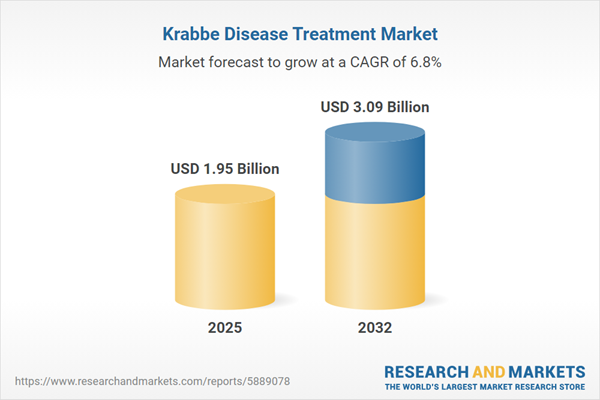Speak directly to the analyst to clarify any post sales queries you may have.
The Krabbe Disease Treatment Market is advancing as innovative gene therapies, improved diagnostic tools, and evolving care models drive new possibilities for rare disease management. Senior decision-makers benefit from clear, action-oriented intelligence tailored to inform strategic positioning and support operational growth in this specialized sector.
Market Snapshot: Krabbe Disease Treatment Market Size and Trends
The Krabbe Disease Treatment Market is on a robust trajectory, increasing from USD 1.83 billion in 2024 to USD 1.95 billion in 2025 and forecasted to reach USD 3.09 billion by 2032. This equates to a compound annual growth rate of 6.77%. Expansion in this field is fueled by enhanced adoption of gene and enzyme therapies, substantial investment in newborn screening technologies, and diagnostic improvements. Growing complexity in this landscape results from diverse patient profiles, evolving clinical intervention strategies, and a range of regional regulatory requirements. For senior executives, establishing in-depth expertise and expanding product offerings is critical to achieving competitive stability and long-term organizational value.
Scope & Segmentation: Strategic Dimensions Driving Market Evolution
- Therapy Type: Includes Enzyme Replacement Therapy, advanced Gene Therapy platforms like AAV2, AAV9, and lentiviral vectors, Hematopoietic Stem Cell Transplantation (allogeneic and autologous), and Supportive Therapy. These diverse therapeutic strategies cater to unique clinical demands and accommodate patient variability.
- Administration Route: Covers precise delivery methods such as Intrathecal routes (intracerebroventricular or lumbar puncture) and systemic Intravenous routes. These enable targeted distribution, enhance therapeutic efficacy, and support complex case management.
- Treatment Setting: Includes specialty inpatient clinics, tertiary hospitals, ambulatory clinics, and home care solutions. The range of settings improves patient access, promotes better health outcomes, and utilizes advances in outpatient care and remote monitoring.
- Distribution Channel: Encompasses hospital pharmacies, retail pharmacies, online platforms, and specialty pharmacies. This supports adaptive supply chain models and responsive logistics for varying clinical and patient requirements.
- End User: Targets clinics, hospitals, and home care providers, including multispecialty and specialty care teams. By focusing on pediatric and adult groups, solutions remain relevant throughout the patient journey.
- Patient Age Group: Spans Infantile (symptomatic), Late Onset (adolescent and adult), and Neonatal (pre-symptomatic, early diagnosis) categories. Tailored protocols are designed for each group, enabling adaptive care pathways and timely intervention.
- Regional Coverage: Addresses the Americas, Europe, Middle East & Africa, and Asia-Pacific, including major markets like the United States, Germany, China, and Japan. Market responses reflect differences in reimbursement policies, access, and regulatory oversight.
- Key Companies: Features Passage Bio, Bluebird Bio, Généthon, Forge Biologics, and Polaryx Therapeutics, recognized for leading clinical innovation and setting industry standards.
Key Takeaways: Strategic Insights for Senior Leaders
- Early intervention models and presymptomatic therapies are transforming initial care strategies and have the potential to improve clinical and economic results for affected individuals.
- Innovations in vector engineering enhance the targeting accuracy of gene therapies, particularly for central nervous system involvement when using intrathecal administration routes.
- Personalized protocols and adaptable treatments address the broad diversity of disease presentations, making therapy customization a strategic necessity.
- Collaborative partnerships between industry, academia, and advocacy organizations are accelerating clinical advancements and supporting alignment with regulatory demands.
- Integrated production systems and strong real-world data practices are streamlining supply chain processes and strengthening positions in reimbursement discussions.
- Flexible distribution through both traditional and specialty pharmacies ensures steady therapy delivery, supporting resilience across varying healthcare systems worldwide.
Tariff Impact: Navigating U.S. 2025 Tariff Dynamics
New U.S. tariffs are introducing higher costs for clinical inputs in the Krabbe Disease Treatment Market. Companies are meeting these headwinds by scaling in-country manufacturing, expanding cross-industry alliances, and enhancing logistical resilience to protect supply continuity under evolving policy conditions.
Methodology & Data Sources
This analysis is based on direct interviews with clinicians, regulatory experts, and payers, supplemented by medical advisory panel input. Data sources include published academic literature, confidential pipeline data, regulatory filings, and key healthcare policy documents. This strategy ensures reliable, in-depth market findings.
Why This Report Matters: Value for Healthcare Decision-Makers
- Presents a comprehensive overview of new technologies, segmentation, and regulatory shifts shaping the Krabbe Disease Treatment Market's outlook.
- Equips senior executives with actionable tools to benchmark strategic direction and inform investment, operational, and planning decisions.
- Supports leaders in navigating complex supply, reimbursement, and policy challenges distinctive to rare disease markets.
Conclusion
The Krabbe Disease Treatment Market is characterized by continuous scientific development and dynamic stakeholder collaboration. Armed with timely data, leaders can confidently guide their organizations through rare disease treatment challenges with strategic foresight.
Additional Product Information:
- Purchase of this report includes 1 year online access with quarterly updates.
- This report can be updated on request. Please contact our Customer Experience team using the Ask a Question widget on our website.
Table of Contents
3. Executive Summary
4. Market Overview
7. Cumulative Impact of Artificial Intelligence 2025
List of Figures
Samples

LOADING...
Companies Mentioned
The key companies profiled in this Krabbe Disease Treatment market report include:- Passage Bio, Inc.
- Bluebird Bio, Inc.
- Généthon
- Forge Biologics
- Polaryx Therapeutics
Table Information
| Report Attribute | Details |
|---|---|
| No. of Pages | 180 |
| Published | October 2025 |
| Forecast Period | 2025 - 2032 |
| Estimated Market Value ( USD | $ 1.95 Billion |
| Forecasted Market Value ( USD | $ 3.09 Billion |
| Compound Annual Growth Rate | 6.7% |
| Regions Covered | Global |
| No. of Companies Mentioned | 6 |









